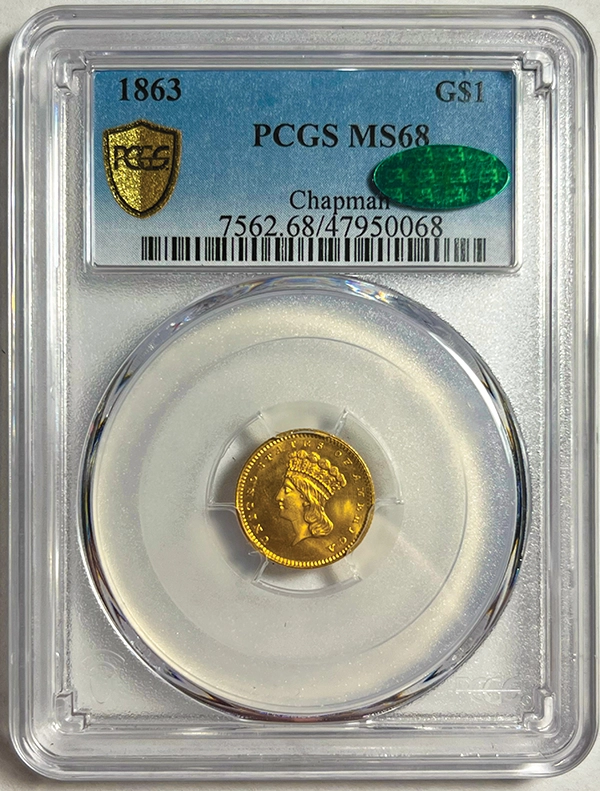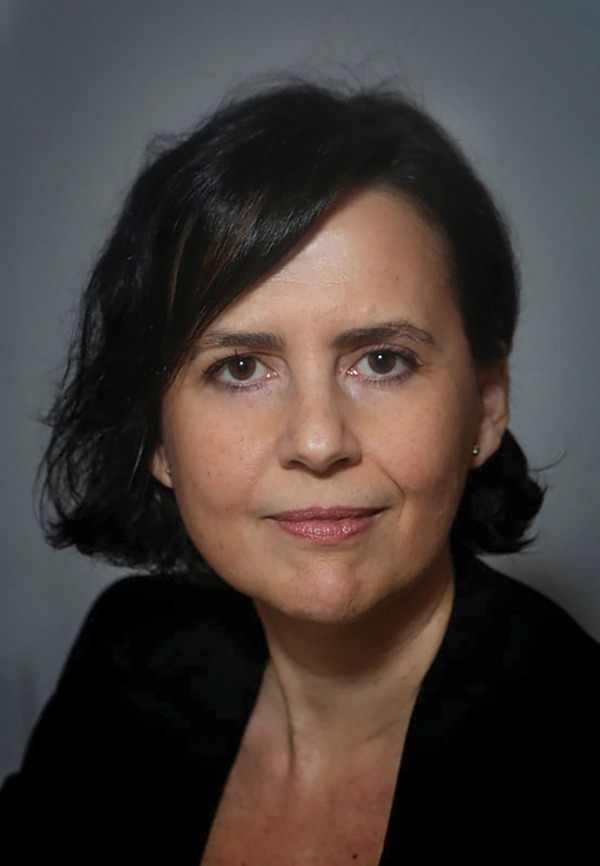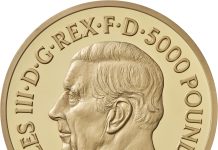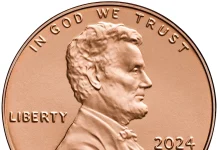
A previously unreported, nearly complete date set of 19th-century United States $1 denomination gold coins assembled by legendary Philadelphia dealer Henry Chapman has been revealed by Matador Rare Coins in New York City.
Stored until recently in a Philadelphia bank vault and safe deposit boxes for more than a century, the formerly hidden collection has 51 Liberty Head and Indian Princess Head dollars struck between 1849 and 1889, as well as eight U.S. commemorative gold dollars struck in the first decades of the 20th century.
The set, now described as The Henry Chapman Collection of $1 Gold, has been owned and securely stored for generations by a Philadelphia-area family. The current owners thought their ancestors’ coins might be worth about $50,000, but they are now insured for $2 million, according to Luis Martinez, founder and president of Matador Rare Coins. He is working with the set’s owners.

“Chapman personally began assembling this collection for a banking family in 1899 and the coins have remained in the family’s possession continuously for generations. The set includes several coins among the finest known examples of their kind today and there are gold dollars struck at the Charlotte, Dahlonega, New Orleans, Philadelphia and San Francisco Mints,” Martinez said.
“When I received the coins, I carefully reviewed each example. Housed in the original envelopes from Henry Chapman’s shop in Philadelphia, a number of the coins carried exuberant eye appeal. I was truly in awe as I reviewed each coin one at a time. I knew then that this collection could truly be a national treasure,” he explained.
All the coins are now certified by Professional Coin Grading Service (PCGS) with the Chapman pedigree indicated on the encapsulated insert label.
“PCGS is proud to have been able to unite these coins with their impressive pedigree at the September 2023 Long Beach Expo,” said PCGS president Stephanie Sabin. “This historic collection boasts not only magnificent rarities and grades, but also hails from the cabinets of renowned collector Henry Chapman. Preserving the coins themselves and their history is an honor.”
Martinez was elated about the grading results. “The grading results were beyond my expectations, with a number of the coins reaching the finest-known tier,” he said. “When I shared the results with the owners, they were astonished and filled with disbelief. A collection they would have sold for about $50,000 could now potentially bring in well over seven figures at auction.”
Among the highlights are an 1863 gold dollar graded PCGS Mint State-68 CAC (Certified Acceptance Corporation) and tied for finest known; an 1881 graded PCGS Proof-66 Deep Cameo and tied for finest known among the remaining survivors of only 87 struck; an 1884 graded PCGS Proof-67+ Cameo CAC tied with one other for finest known; and an 1887 graded PCGS Mint State-67+ CAC. An example of the 1875 $1 gold—with a small mintage of only 400—is graded PCGS About Uncirculated-58 CAC.
“The U.S. began making $1 gold pieces in 1849, a year after the start of the California Gold Rush. A little smaller than a modern U.S. dime, the gold dollars were struck over the years with three different designs—Liberty Head from 1849 to 1854, Indian Princess Small Head from 1854 to 1856, and the Indian Princess Large Head type from 1856 to 1889,” Martinez explained.
Over the years at various times, five mints were involved in striking $1 gold coins: Charlotte, North Carolina; Dahlonega, Georgia; New Orleans, Louisiana; Philadelphia, Pennsylvania; and San Francisco, California.
The commemorative gold coins in the collection include a 1903 Louisiana Purchase McKinley graded PCGS Mint State-68 and tied for finest known; a 1905 Lewis and Clark graded PCGS Mint State-67; 1915-S Panama-Pacific graded Mint State-67; 1917 McKinley graded PCGS Mint State-67, and a 1922 Grant With Star variety graded PCGS Mint State-67+ CAC.
Additional specific information about each of the coins in The Henry Chapman Collection of $1 Gold will be released soon, according to Martinez.
John Albanese, founder of CAC Grading, LLC, was surprised to learn about the long-concealed gold dollars and then view them in person: “I’ve been around the numismatic block a few times since the 1970s and thought we’ve seen probably everything there is to see in great collections. I almost fell off the chair when these coins came in. It’s nice to know there are still great coins out there. It gives us hope.”
Henry Chapman and his brother, Samuel Hudson (S.H.) Chapman, were well-known late-19th and early 20th-century Philadelphia coin dealers and auctioneers. Numismatic bibliographer Pete Smith describes the Chapman brothers as “the first career coin dealers in the United States” who were “innovative with the use of photographic plates to illustrate their catalogs.”
For additional information about the set, contact Matador Rare Coins at 877-757-3665 or visit www.MatadorRareCoins.com.
Idaho Young Coin Collector is 2024 Professional Numismatists Guild Scholarship Recipient
A young numismatist from Coeur D’ Alene, Idaho, Donivan Floyd, 19, was the winner of the 2024 Professional Numismatists Guild (PNG) annual scholarship award competition.
“The PNG scholarship covered airfare, tuition for one of the two June 2024 American Numismatic Association (ANA) Summer Seminar sessions, meals and dormitory accommodations on the campus of Colorado College, adjacent to the ANA headquarters,” said PNG Executive Director John Feigenbaum.

Floyd grew up in a coin shop, DJ’s Coins & Collectibles, owned by his father David J. Floyd, but only began collecting five years ago at the age of 14. “I wanted a job at my dad’s shop. I never thought I would like coins and never had too much interest in it, but once I learned more about the field, I really started to grow passionate about grading and modern coins. My favorite coins are Jefferson nickels,” he said.
Aside from gaining knowledge of numismatics from his father and others, Floyd is a participant in PNG’s nextGen Mentorship program to assist young and future dealers. He was mentored by PNG Board of Directors member James Sego of JMS Coins, also of Coeur D’ Alene.
Floyd launched his own online coin business Modern Coin King. three years ago. “I hope to further grow my knowledge on U.S coins and grading, running my business, and to become a useful asset and leader in numismatics,” Floyd stated in his essay submitted as part of the PNG scholarship competition.
“We are delighted that Donivan Floyd is gaining valuable insight and knowledge about the hobby and business, and is following the core values of PNG and our high standards for reputation, integrity, and responsibility,” stated Feigenbaum.
For additional information about PNG or the young numismatists scholarship program, visit online at www.PNGdealers.org or call (951) 587-8300, and for information about the PNG’s nexGen Mentorship program, visit https://www.pngdealers.org/png-nexgen.
For information about the annual ANA Summer Seminar, visit www.money.org/summer-seminar.
American Numismatic Society Presents Huntington Award to Dr. Ruth Pliego
The Trustees of the American Numismatic Society (ANS) have named Dr. Ruth Pliego as the recipient of the 2023 Archer M. Huntington Medal Award for Excellence in Numismatic Scholarship. The award was presented on June 13, 2024, at the ANS headquarters in New York City, followed by the Silvia Mani Hurter Memorial Lecture by the honoree: “Archer M. Huntington and the Visigothic Coins: Revisiting the La Capilla Hoard.”
Dr. Ruth Pliego holds a Ph.D. from the University of Seville in Spain (2006), where she serves as a lecturer and researcher in the Department of Prehistory and Archaeology. She has been involved with the Casa de Velázquez in Madrid (2012-2013) and as a research fellow at the Paris Institute for Advanced Study and the École Pratique des Hautes Études (2017-2018). Her research residencies include the University of Padua (2018), the University of Hamburg (at the Roman Islam Center, 2020) and the University of Lisbon (2020-2021).

Pliego has published extensively on the coinage of the Visigothic kingdom, including the two-volume La moneda visigoda (Sevilla, 2009), since updated with “La moneda visigoda: Anexo I” (2012) and “Visigothic currency: Recent developments and data for its study” (2020). Her other interests include a comprehensive approach to examining Visigothic bronze coins from a broader Mediterranean perspective (“Rethinking the minimi of the Iberian peninsula and Balearic islands in the Late Antiquity,” 2020). Her research has intersected with her work in the digital humanities applied to numismatics within the framework of Monedaiberica.org. Pliego has been part of the FLAME (Framing the Late Antique and Early Medieval Economy) Project at Princeton University since 2015 and is involved in the study of the Roman Tetrarchic hoard of Tomares at the Archaeological Museum of Seville-University. She is currently co-coordinator on the “La Monnaie dans l’Occident Méditerranéen” (MONOM) Project at Casa de Velázquez, Madrid.
The Archer M. Huntington Award is conferred annually in honor of the late Archer M. Huntington, president of the ANS from 1905–1910, and was first presented to Edward T. Newell in 1918. In 2023, the Society commissioned a new medal for the award, designed by Eugene L. Daub.











